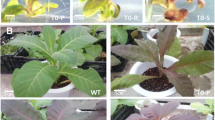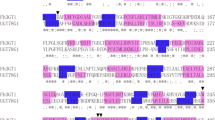Abstract
Anthocyanins and flavan-3-ols are distributed widely in plants and synthesized by a common biosynthetic pathway. Anthocyanin reductase (ANR) represents branching-point enzyme of this pathway converting anthocyanidins to flavan-3-ols. Since tea contains highest amount of flavonoids, a cDNA encoding anthocyanin reductase from tea (CsANR) was overexpressed in transgenic tobacco to check the influence on anthocyanin and flavan-3-ols. The transgenic tobacco was confirmed by genomic PCR and expression of transgene was analyzed through semiquantitative PCR. Interestingly flowers of transgenic tobacco were light pink/white in color instead of dark pink in wild tobacco, documenting the decrease in anthocyanins content. Upon measurement, flower anthocyanin content was found to be lesser. While flavan-3-ols (epicatechin and epigallocatechin) contents were increased in leaf tissue of transgenic lines. The expressions of other endogenous flavonoid biosynthetic pathway genes in different floral parts (sepal, petal, stamen, and carpel) of CsANR overexpressing tobacco as well as wild tobacco were analyzed. The transcript levels of PAL and CHI genes were downregulated, while transcript levels of F3H, FLS, CHS, ANR1, and ANR2 genes were upregulated in all floral parts of CsANR transgenic plants compared to wild tobacco. The expressions of DFR and ANS genes were also spatially modulated in different floral parts due to overexpression of CsANR. Thus, CsANR overexpression increased flavan-3-ols and decreased anthocyanin content by modulating the expressions of various flavonoid biosynthetic pathway genes in flower of tobacco. These changes might be responsible for the observed pollen tube in the pollens of CsANR overexpressing transgenic tobacco when they were still in the anther before pollination.






Similar content being viewed by others
References
Schaefer, H. M., Schaefer, V., & Vorobyev, M. (2007). Are fruit colors adapted to consumer vision and birds equally efficient in detecting colorful signals? American Naturalist, 169, S159–S169.
Aron, P. M., & Kennedy, J. A. (2008). Flavan-3-ols: nature, occurrence and biological activity. Molecular Nutrition Food Research, 52, 79–104.
Lepiniec, L., Debeaujon, I., Routaboul, J. M., Baudry, A., Pourcel, L., Nesi, N., et al. (2006). Genetics and biochemistry of seed flavonoids. Annual Review in Plant Biology, 57, 405–430.
Pang, Y. P., Peel, G. J., Wright, E., Wang, Z., & Dixon, R. A. (2007). Early steps in proanthocyanidin biosynthesis in the model legume Medicago truncatula. Plant Physiology, 145, 601–615.
Terrier, N., Torregrosa, L., Ageorges, A., Vialet, S., Verries, C., Cheynier, V., et al. (2009). Ectopic expression of VvMybPA2 promotes proanthocyanidin biosynthesis in Vitis vinifera L. and suggests additional targets in the pathway. Plant Physiology, 149, 1028–1041.
Aharoni, A., Ric De Vos, C. H., Wein, M., Sun, Z., Greco, R., Kroon, A., et al. (2001). The strawberry FaMYB1 transcription factor suppresses anthocyanin and flavonol accumulation in transgenic tobacco. The Plant Journal, 28, 319–332.
Jaakola, L., Maatta, K., Pirttila, A. M., Torronen, R., Karenlampi, S., & Hohtola, A. (2002). Expression of genes involved in anthocyanin biosynthesis in relation to anthocyanin, proanthocyanidin, and flavonol levels during bilberry fruit development. Plant Physiology, 130, 729–739.
Abeynayake, S. W., Panter, S., & Chapman, R. (2012). Biosynthesis of proanthocyanidins in white clover (Trifolium repens L.) flowers: cross-talk within the flavonoid pathway. Plant Physiology, 158, 666–678.
Schwinn, K., Venail, J., Shang, Y., Mackay, S., Alm, V., Butelli, E., et al. (2006). A small family of MYB-regulatory genes controls floral pigmentation intensity and patterning in the genus Antirrhinum. The Plant Cell, 18, 831–851.
Park, K. I., Ishikawa, N., Morita, Y., Choi, J. D., Hoshino, A., & Lida, S. (2007). A bHLH regulatory gene in the common morning glory, Ipomoea purpurea, controls anthocyanin biosynthesis in flowers, proanthocyanidin and phytomelanin pigmentation in seeds, and seed trichome formation. The Plant Journal, 49, 641–654.
Gargouri, M., Manigand, C., Mauge, C., Granier, T., Langlois d’Estaintot, B., Cala, O., et al. (2009). Structure and epimerase activity of anthocyanidin reducate from Vitis vinifera. Acta Crystallographica, D65, 989–1000.
Fukuchi-Mizutani, M., Okuhara, H., Fukui, Y., Nakao, M., Katsumoto, Y., Yonekura-Sakakibara, K., et al. (2003). Biochemical and molecular characterization of a novel UDP-glucose: Anthocyanin 3′-o-Glucosyltransferase, a key enzyme for blue anthocyanin biosynthesis, from gentian. Plant Physiology, 132, 1652–1663.
Xie, D. Y., Sharma, S. B., Paiva, N. L., Ferreira, D., & Dixon, R. A. (2003). Role of anthocyanidin reductase, encoded by BANYULS in plant flavonoid biosynthesis. Science, 299, 396–399.
Xie, D. Y., Sharma, S. B., & Dixon, R. A. (2004). Anthocyanidin reductases from Medicago truncatula and Arabidopsis thaliana. Archives of Biochemistry and Biophysics, 422, 91–102.
Pfeiffer, J., Kuhnel, C., Brandt, J., Duy, D., Punyasiri, P., Forkmann, G., et al. (2006). Biosynthesis of flavan-3-ols by leucoanthocyanidin 4-reductases and anthocyanidin reductases in leaves of grape (Vitis vinifera L.), apple (Malus domestica Borkh.) and other crops. Plant Physiology and Biochemistry, 44, 323–334.
Paolocci, F., Robbins, M. P., Madeo, L., Arcioni, S., Martens, S., & Damiani, F. (2007). Ectopic expression of a basic helix-loop-helix gene transactivates parallel pathways of proanthocyanidin biosynthesis. Structure, expression analysis, and genetic control of leucoanthocyanidin 4-reductase and anthocyanidin reductase genes in Lotus corniculatus. Plant Physiology, 143, 504–516.
Bogs, J., Downey, M. O., Harvey, J. S., Ashton, A. R., Tanner, G. T., & Robinson, S. P. (2005). Proanthocyanidin synthesis and expression of genes encoding leucoanthocyanidin reductase and anthocyanidin reductase in developing grape and grapevine leaves. Plant Physiology, 139, 652–663.
Singh, K., Rani, A., Paul, A., Dutt, S., Joshi, R., Gulati, A., et al. (2009). Differential display mediated cloning of anthocyanidin reductase gene from tea (Camellia sinensis) and its relationship with the concentration of epicatechins. Tree Physiology, 29, 837–846.
Kovinich, N., Saleem, A., Rintoul, T., L., Brown, D., C., W., Arnason, J., T., & Miki, B. (2011). Coloring genetically modified soybeans grains with anthocyanins by suppression of the proanthocyanidins genes ANR1 and ANR2. Transgenic Research. doi:10.1007/s11248-011-9566-y.
Han, Y., Vimolmangkang, S., Soria-Guerra, R., E., & Korban, S., S. (2012). Introduction of apple ANR genes into tobacco inhibits expression of both CHI and DFR genes in flowers, leading to loss of anthocyanin. Journal of Experimental Botany. doi:10.1093/jxb/err415.
Kumar, V., & Yadav, S., K. (2012). Developmental effect on transcript expression of genes encoding enzymes for flavan-3-ols synthesis and its content in leaves and flowers of tea (Camellia sinensis (L.) O. Kuntze). International Journal of Plant Developmental Biology (in press).
Kumar, V., Gill, T., Grover, S., Ahuja, P. S., & Yadav, S., K. (2012). Influence of human lactoferrin expression on iron homeostasis, flavonoids, and antioxidants in transgenic tobacco. Molecular Biotechnology, doi: 10.1007/s12033-012-9495-x.
Singh, K., Raizada, J., Bhardwaj, P., Ghawana, S., Rani, A., & Singh, S. (2004). 26S rRNA-based internal control gene primer pair for reverse transcription-polymerase chain reaction-based quantitative expression studies in diverse plant species. Analytical Biochemistry, 335, 330–333.
Mahajan, M., Ahuja, P. S., & Yadav, S. K. (2011). Post-transcriptional silencing of flavonol synthase mRNA in tobacco leads to fruits with arrested seed set. PLoS One, 6, e28315.
Paolocci, F., Robbins, M. P., Passeri, V., Hauck, B., Morris, P., et al. (2011). The strawberry transcription factor FaMYBI inhibits the biosynthesis of proanthocyanidins in Lotus carniculatus leaves. Journal of Experimental Botany, 62, 1189–1200.
Rosati, C., & Simoneau, P. (2008). Metabolic engineering of flower color in ornamental plants. Journal of Crop Improvement, 18, 301–324.
Gould, K., Davies, K., & Winefield, C. (Eds.). (2009). Anthocyanins: Biosynthesis, functions, and application. Dordrecht: Springer.
Tanaka, Y., Brugliera, F., Kalc, G., Senior, M., Dyson, B., Nakamura, N., et al. (2010). Flower color modification by engineering of the flavonoid biosynthesis pathway: Practical perspectives. Bioscience, Biotechnology, and Biochemistry, 74, 1760–1769.
Nishihara, M., & Nakatsuka, T. (2011). Genetic engineering of flavonoid pigments to modify flower color in floricultural plants. Biotechnology Letters, 33, 433–441.
Joung, J. Y., Mangai, K. G., Park, J. Y., Kang, W. J., Kim, H. S., Yoon, B. S., et al. (2003). An overexpression of chalcone reductase of Pueraria montana var. lobata alters biosynthesis of anthocyanin and 5′-deoxyflavonoids in transgenic tobacco. Biochemical and Biophysical Research Communications, 303, 326–331.
Davies, K. M., Bloor, S. J., Spiller, G. B., & Deroles, S. C. (1998). Production of yellow color in flowers: Redirection of flavonoid biosynthesis in petunia. The Plant Journal, 13, 259–266.
Zhang, X., Liu, Y., Gao, K., Zhao, L., Liu, L., Wang, Y., et al. (2011). Characterization of anthocyanidin redcutase from shuchazao green tea. Journal of the Science of Food and Agriculture, 92, 1533–1539.
Han, Y., Vimolmangkang, S., Soria-Guerra, R. E., Rosales-Mendoza, S., Zheng, D., Lygin, A. V., et al. (2010). Ectopic expression of apple F3′H genes contributes to anthocyanin accumulation in the Arabidopsis tt7 mutant grown under nitrogen stress. Plant Physiology, 153, 806–820.
Hiratsu, K., Matsui, K., Koyama, T., & Ohme-Takagi, M. (2003). Dominant repression of target genes by chimeric repressors that include the EAR motif, a repression domain, in Arabidopsis. The Plant Journal, 34, 733–739.
Nishihara, M., Nakatsuka, T., & Yamamura, S. (2005). Flavonoid components and flower color change in transgenic tobacco plants by suppression of chalcone isomerase gene. FEBS Letters, 579, 6074–6078.
Nakatsuka, T., Abe, Y., Kakizaki, Y., Yamamura, S., & Nishihara, M. (2007). Production of red-flowered plants by genetic engineering of multiple flavonoid biosynthetic genes. Plant Cell Reports, 26, 1951–1959.
Stommel, J. R., Lightbourn, G. J., Winkel, B. S., & Griesbach, R. J. (2009). Transcription factor families regulate the anthocyanin biosynthetic pathway in Capsicum annum. Journal of the American Society for Horticultural Science, 134, 244–251.
Wang, C. K., Chen, P. Y., Wang, H. M., & To, K. Y. (2006). Cosuppression of tobacco chalcone synthase using Petunia chalcone synthase construct results in white flowers. Botanical Studies, 47, 71–82.
Polashock, J. J., Griesbach, R. J., Sullivan, R. F., & Vorsa, N. (2002). Cloning of a cDNA encoding the cranberry dihydroflavonol-4-reductase (DFR) and expression in transgenic tobacco. Plant Science, 163, 241–251.
Hsieh, K., & Huang, A. H. C. (2007). Tapetosomes in Brassica tepetum accumulate endoplasmic reticulum-derived flavonoid and alkanes for delivery to the pollen surface. The Plant Cell, 19, 582–596.
Schijlen, E. G. W. M., Ric de Vos, C. H., Martens, S., Jonker, H. H., Rosin, F. M., et al. (2007). RNA interference silencing of chalcone synthase, the first step in the flavonoid biosynthesis pathway, leads to parthenocarpic tomato fruits. Plant Physiology, 144, 1520–1530.
Acknowledgments
Authors are thankful to the Director, CSIR-IHBT, Palampur for providing the necessary facility to conduct the research and suggestions throughout this study. CSIR, GOI is duly acknowledged for providing the financial support to the laboratory and the SRF to VK.
Author information
Authors and Affiliations
Corresponding author
Rights and permissions
About this article
Cite this article
Kumar, V., Yadav, S.K. Overexpression of CsANR Increased Flavan-3-ols and Decreased Anthocyanins in Transgenic Tobacco. Mol Biotechnol 54, 426–435 (2013). https://doi.org/10.1007/s12033-012-9580-1
Published:
Issue Date:
DOI: https://doi.org/10.1007/s12033-012-9580-1




